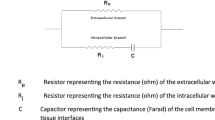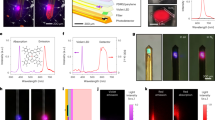Abstract
Using 97 male albino guinea pigs and applying electrophysiological methods, the effects of a 6 kHz tone were investigated at a moderate sound pressure level to the inner ear during a 24-h exposure time. Following exposure to the 6 kHz tone at 90 dB, cochleas showed decreased maximum output voltage of cochlear microphonics (CM) and action potential (AP). In the endolymph, K+ ion and Na+ ion concentrations remained unchanged during 40 min anoxia and 90 dB tone exposure. At 80 dB sound exposure decreases in maximum output voltage of CM and AP and decreases in the absolute value of EP could not be detected. Endolymph K+-ion Na+-ion concentrations were also unchanged. These findings indicate that diffusion potentials are induced at the same time as decreases of maximum output voltage in CM induced by exposure to sound at 90 dB.
Similar content being viewed by others
References
Abe N, Ohyama S, Shida T (1981) Method of fabrication of double barrel K+ ion electrode and its application to physiology of cochlea. Audiology 24:397–398 (in Japanese)
Carrosco EA, Prazma J, Faber JE, Jviana RJ, Dillsbrag HC (1990) Cochlear microcirculation. Arch Otolaryngol Head Neck Surg 116:411–417
Fujii M (1970) The experimental study of acoustic trauma on peripheral hearing organ. Pract Otol 63:557–608
Ishida A, Matsui T, Yamamura K (1993) The effect of low frequency ultra-sound on the inner ear. Eur Arch Otorhinolaryngol 250:22–26
Ito H (1991) Effects of circulatory disturbance on the cochlea. ORL 53:265–269
Konishi T, Salt AN (1980) Permeability to potassium of the endolymph barrier and its possible relation to hair cell function. Exp Brain Res 40:457–463
Konishi T, Salt AN (1983) Electrochemical profiles for potassium ions across the cochlear hair cell membranes of guinea pigs. Hear Res 11: 219–233
Kryter KD (1985) Noise-induced hearing loss and its prediction. In: Kryter KD (ed) The effect of noise on man, 2nd edn. Academic Press, New York, p 220
Legouix JP, Persan A (1974) Investigation of the source of whole-nerve action potential. J Acoust Soc Am 56:1222–1225
Lewis GT, Saunders JC, Egelman E, Derosier (1982) Changes in the organization of action filaments in the stereocilia of noise-damaged lizard cochlear. Hearing Research 7:181–197
Lim DJ (1980) Cochlea anatomy related to cochlear microphonics: a review. J Acoust Soc Am 67:1686–1695
Matsui T, Sugisawa T, Ishida A, Yamamura K (1993) Effect of high-frequency sound on electrochemical potential using the single-barrel method in guinea pigs. ORL 55:84–88
Mori H, Konishi T (1985) Permiability to chloride ions of the cochlear partition in normal guinea pigs. Hearing Research 17:227–236
Morita K (1970) Experimental study of endocochlear potential induced by several load conditions. Jpn J Otol 73: 1421–1453
Muratsuka Y, Ueda H, Konishi T (1989) Effects of sodium bromate on ionic concentrations and osmolalities of the cochlear fluids in guinea pigs. Hear Res 39:241–250
Oftner FF, Dallos P, Cheatham MA (1987) Positive endocochlear potential: mechanism of production by marginal cells of stria vascularis. Hear Res 29:117–124
Ohlsen KA, Didier A, Baldwin D, Miller JM, Nuttall AL and Hultcrantz E (1992) Cochlear blood flow in response to dilating agents. Hear Res 58:19–25
Pickles JO, Comis SD, Osborne MP (1984) Cross-lines between stereocilia in the guinea pig organ of corti and their possible relation to sensory transduction. Hear Res 15:103–112
Ryan AF, Axelsson GA, Woolf NK (1992) Central auditory metabolic activity induced by intense noise exposure. Hear Res 61:24–30
Saunders JC, Cohen YE, Szymko YM (1991) The structual and functional consequences of acoustic injury in the cochlea and peripheral auditory system: a five year update. J Acoust Soc Am 90:136–146
Shige E (1978) Fluorescent microscopic study on adrenergic innervation of the arteries coursing from the base of skull to the inner ear. Adv Neuro Sci 22:1336–1345
Sugisawa T, Ishida A, Yamamura K (1994) The effect of 4 kHz tone exposure on the guinea pig inner ear: Relation in the change of CM, AP, electrochemical potential and chemical potential induced by noise exposure. ORL (in press)
Tasaki I, Davis H, Legouix JP (1952) The space time pattern of the cochlear microphonics (guinea pigs), as recorded by differential electrodes. J Acoust Soc Am 24:502–519
Author information
Authors and Affiliations
Rights and permissions
About this article
Cite this article
Sugisawa, T., Ishida, A., Hotta, S. et al. The effect of 6 kHz tone exposure on inner ear function of the guinea pig: relation to changes in cochlear microphonics, action potential, endocochlear potential and chemical potentials of K+-ions and Na+-ions, using a double-barrel glass electrode. Eur Arch Otorhinolaryngol 251, 154–159 (1994). https://doi.org/10.1007/BF00181827
Received:
Accepted:
Issue Date:
DOI: https://doi.org/10.1007/BF00181827




